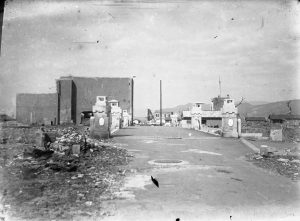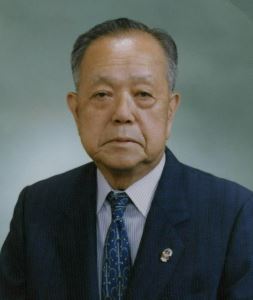Documenting Hiroshima of 1946: In March, Dr. Tomin Harada returns to Japan
Mar. 8, 2025
by Maho Yamamoto, Staff Writer
In March 1946, Tomin Harada, a 34-year-old surgeon at the time who died in 1999 at the age of 87, was discharged from the military and returned to Hiroshima from Taiwan, where he had been serving as an Army physician. No traces remained of the hospital he had operated in Hiroshima’s Nakajima-honmachi area (present-day Peace Memorial Park, in the city’s Naka Ward), near the hypocenter.
On March 8, he set off on his journey home and arrived at Otake Port by ship after around one week at sea. Changing trains, he headed to the Furuichibashi area in the snow. Catching a glimpse of scenes from the train window, he cried out in sorrow, “It’s vanished! Hiroshima’s vanished!” That description appeared in his autobiography titled Hiroshima no Gekai no Kaiso (in English, “Hiroshima Surgeon”), published in 1977 (quoted information below taken from same publication). He was reunited with his wife, children, and parents at their family home in the village of Yasu (in Hiroshima’s present-day Asaminami Ward). He was told the story of how, in the immediate aftermath of the atomic bombing, people had formed long lines every day to see his father, who was also a physician.
However, Tomin Harada had contracted malaria and took to his bed starting the next day. While delirious with a high fever, “I had a flash of inspiration that I must build a hospital near the hypocenter.” According to a history of the Hiroshima City Medical Association published in 1980, 270 of the 298 physician members listed in the association’s register, or 90%, had experienced the atomic bombing directly. It is believed that as many as 225 of all physicians had been killed in the bombing. The surviving physicians continued to practice medicine in the city’s outlying areas.
After recovering, Mr. Harada began to work on plans to build a new hospital in the ruins. He leased land in the area of Hirose-machi (in Hiroshima’s present-day Naka Ward) from someone who was in a lower grade when they were in junior high school. He obtained financing from Hiroshima Bank and asked a relative to handle the construction work. In November, he opened the Harada Surgical Hospital in a two-story, wooden shack-like structure with around 20 beds.
His son, Yoshihiro, 88, a physician who lives in Hiroshima’s Naka Ward, said, “His entire life, my father believed that treatment related to the atomic bombing should be provided free of charge.” His father used to also cover the transportation expenses for patients traveling from outside Hiroshima Prefecture.
Mr. Harada gathered together 10 surgeons who had survived the atomic bombing and reestablished the Hiroshima Surgical Society. In 1948, he organized a study group called the “Doyo-kai” (in English, the ‘Saturday club’) for private practitioners, where they would each report on cases of keloid scarring and other aftereffects of A-bomb radiation, such as increases in leukemia and cancer, from the perspective of their own specialties. In 1955, he accompanied a group of women who traveled to the United States to undergo treatment for their keloid scars.
(Originally published on March 8, 2025)
In March 1946, Tomin Harada, a 34-year-old surgeon at the time who died in 1999 at the age of 87, was discharged from the military and returned to Hiroshima from Taiwan, where he had been serving as an Army physician. No traces remained of the hospital he had operated in Hiroshima’s Nakajima-honmachi area (present-day Peace Memorial Park, in the city’s Naka Ward), near the hypocenter.
On March 8, he set off on his journey home and arrived at Otake Port by ship after around one week at sea. Changing trains, he headed to the Furuichibashi area in the snow. Catching a glimpse of scenes from the train window, he cried out in sorrow, “It’s vanished! Hiroshima’s vanished!” That description appeared in his autobiography titled Hiroshima no Gekai no Kaiso (in English, “Hiroshima Surgeon”), published in 1977 (quoted information below taken from same publication). He was reunited with his wife, children, and parents at their family home in the village of Yasu (in Hiroshima’s present-day Asaminami Ward). He was told the story of how, in the immediate aftermath of the atomic bombing, people had formed long lines every day to see his father, who was also a physician.
However, Tomin Harada had contracted malaria and took to his bed starting the next day. While delirious with a high fever, “I had a flash of inspiration that I must build a hospital near the hypocenter.” According to a history of the Hiroshima City Medical Association published in 1980, 270 of the 298 physician members listed in the association’s register, or 90%, had experienced the atomic bombing directly. It is believed that as many as 225 of all physicians had been killed in the bombing. The surviving physicians continued to practice medicine in the city’s outlying areas.
After recovering, Mr. Harada began to work on plans to build a new hospital in the ruins. He leased land in the area of Hirose-machi (in Hiroshima’s present-day Naka Ward) from someone who was in a lower grade when they were in junior high school. He obtained financing from Hiroshima Bank and asked a relative to handle the construction work. In November, he opened the Harada Surgical Hospital in a two-story, wooden shack-like structure with around 20 beds.
His son, Yoshihiro, 88, a physician who lives in Hiroshima’s Naka Ward, said, “His entire life, my father believed that treatment related to the atomic bombing should be provided free of charge.” His father used to also cover the transportation expenses for patients traveling from outside Hiroshima Prefecture.
Mr. Harada gathered together 10 surgeons who had survived the atomic bombing and reestablished the Hiroshima Surgical Society. In 1948, he organized a study group called the “Doyo-kai” (in English, the ‘Saturday club’) for private practitioners, where they would each report on cases of keloid scarring and other aftereffects of A-bomb radiation, such as increases in leukemia and cancer, from the perspective of their own specialties. In 1955, he accompanied a group of women who traveled to the United States to undergo treatment for their keloid scars.
(Originally published on March 8, 2025)









